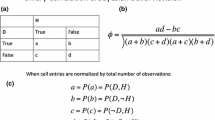Abstract
Many public information documents attempt to persuade the recipients that they should engage in or refrain from specific behaviour. This is based on the assumption that the recipient will decide about his or her behaviour on the basis of the information given and a rational evaluation of the pros and cons. An analysis of 20 public information brochures shows that the argumentation in persuasive brochures is often not marked as such. Argumentation is presented as factual information, and in many instances the task of making argumentational links and drawing conclusions is left to the reader. However, since the information offered does follow familiar argumentational schemes, readers can, in principle, reconstruct the argument. All the brochures make use of pragmatic argumentation (argumentation from consequences),i. e.,they formulate at least certain benefits of the desirable behaviour or disadvantages of the undesirable behaviour. In addition, they make regular use of argumentation from cause to effect and argumentation from example. Argumentation from rules and argumentation from authority are less frequently used. This empirical analysis of the use of argumentation schemes is a solid base for interesting and rich hypotheses about the cognitive processing of persuasive brochures. Central processing requires the reader to be able to reconstruct argumentation from informational texts and to identify and evaluate various types of argumentation.
Similar content being viewed by others
REFERENCES
Blair, J.A.: 1999,“ [Book Review of ] D.N. Walton, Argumentation Schemes for Presumptive Reasoning”, Argumentation 13, 338-343.
Eemeren, F.H. van and R. Grootendorst: 1992, Argumentation,Communication,and Fallacies.A Pragma-dialectical Perspective, Lawrence Erlbaum, Hillsdale,NJ.
Freeley, A.J.:1976, Argumentation and Debate.Rational Decision Making (4th edition), Wadsworth, Belmont,Calif.
Garssen, B.: 1997, Argumentatieschema's in pragma-dialectisch perspectief.Een theoretisch en empirisch onderzoek (Argumentschemes from a pragma-dialectical perspective.A theoretical and empirical study). Ph.D.Dissertation.Universiteit van Amsterdam, IFOTT.
Garssen, B.:2001,“Argument Schemes”,in F.H. van Eemeren (ed.), Crucial Concepts in Argumentation Theory, Amsterdam University Press, Amsterdam, 81 -99.
Gottlieb, G.: 1968, The Logic of Choice. An Investigation of the Concepts of Rule and Rationality, Allen and Unwin, London.
Hare, R.M.:1952, The Language of Morals, Oxford University Press, Oxford.
Hastings, A.C.:1962, A Reformulation of the Modes of Reasoning in Argumentation.Ph.D. Dissertation. Northwestern University, Evanston,Ill.
Hoeken, H.:1995, The Design of Persuasive Texts:Effects of Content,Structure,and Style. Ph.D.Dissertation. Katholieke Universiteit Brabant, Tilburg.
Kienpointner, M.:1992, Alltagslogik. Struktur und Funktion von Argumentationsmustern, Fromann-Holzboog, Stuttgart-Bad Constatt.
Perelman, Ch. and L. Olbrechts-Tyteca: 1969, The New Rhetoric. A Treatise on Argumentation, University of Notre Dame Press, Notre Dame/London.
Petty, R. E. and J. T. Cacioppo: 1986, Communication and Persuasion. Central and Peripheral Routes to Attitude Change, Springer, New York.
Petty, R. E. and J. T. Cacioppo: 1984,“ The Effects of Involvement on Responses to Argument Quantity an Quality:Central and Peripheral Routes to Persuasion”, Journal of Personality and Social Psychology 46, 69 -81.
Petty, R. E., C. P. Haugtvedt and S.M. Smith: 1995,“ Elaboration as a Determinant of Attitude Strength:Creating Attitudes that are Persistent,Resistant,and Predictive of Behavior”, in R.E. Petty and J.A. Krosknick (eds.), Attitude Strength. Antecedents and Consequences, Erlbaum, Mahwah, NJ, 93 -130.
Petty, R.E. and J.R. Priester: 1994,“ Mass Media Attitude Change:Implications of the Elaboration Likelihood Model of Persuasion”, in J. Bryant and D. Zillmann (eds.), Media Effects. Advances in Theory and Research, Lawrence Erlbaum, Hillsdale NJ, 91 -122.
Schellens, P.J.: 1985, Redelijke argumenten.Een onderzoek naar normen voor kritische lezers (Reasonable arguments. A study in criteria for critical reading). Ph.D. Dissertation. Rijksuniversiteit Utrecht, Foris,Dordrecht.
Schellens, P.J.: 1987,“ Types of Argument and the Critical Reader”, in F.H. van Eemeren, R. Grootendorst, J.A. Blair and Ch.A. Willard (eds.), Argumentation:Analysis and Practices, Foris, Dordrecht, 34 -41.
Schellens, P.J.and G. Verhoeven:1994, Argument en tegenargument (Argument and Counterargument), Martinus Nijhoff, Groningen.
Toulmin, S., R. Rieke and A. Janik:1979, An Introduction to Reasoning, Macmillan, New York.
Walton, D.N.:1996, Argumentation Schemes for Presumptive Reasoning, Lawrence Erlbaum, Mahwah, NJ.
Windes, R.R.and A. Hastings:1969, Argumentation & advocacy (4th edition), Random House, New York.
Woods, J. and D. Walton: 1982, Argument: the Logic of the Fallacies, McGraw-Hill Ryerson, Toronto.
Author information
Authors and Affiliations
Rights and permissions
About this article
Cite this article
Schellens, P.J., De Jong, M. Argumentation Schemes in Persuasive Brochures. Argumentation 18, 295–323 (2004). https://doi.org/10.1023/B:ARGU.0000046707.68172.35
Issue Date:
DOI: https://doi.org/10.1023/B:ARGU.0000046707.68172.35



